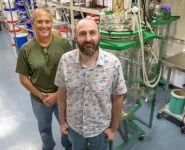(Press-News.org) A $5.3 million National Institutes of Health grant awarded to the University of Oklahoma Health Sciences will support advanced cancer research in Oklahoma. The Centers of Biomedical Research Excellence (COBRE) grant is designed to build research capacity and help early-career researchers establish independently funded laboratories.
This is the third and final phase of the COBRE grant, which was first awarded in 2012, followed by phase two in 2017. The grant has supported and paralleled the growth of OU Health Stephenson Cancer Center, Oklahoma’s National Cancer Institute-designated cancer center.
Danny Dhanasekaran, Ph.D., a professor of cell biology at the OU College of Medicine and deputy director for basic research at Stephenson Cancer Center, has led the grant’s work since its beginning.
“The phase three COBRE grant is a testament to the tremendous progress we have made over the past decade in advancing cancer research in Oklahoma,” Dhanasekaran said. “With the continued support of the NIH, we are poised to make significant strides in understanding and overcoming the challenges of cancer, ultimately improving outcomes for cancer patients in Oklahoma and across the nation.”
As part of the COBRE grant, established researchers mentor early-career researchers on important steps and pitfalls to avoid as they launch their careers. Early-career researchers conduct research and publish studies that they leverage to apply for larger grants to sustain their labs. They also become immersed in the collaborative world of team science.
“Research has become so multifaceted that one group won’t have all the expertise,” Dhanasekaran said. “For example, one researcher may be very good at teasing out how a cancer cell ‘talks’ to another cancer cell to promote growth, but they may not be as good at drug delivery, so they partner with a lab that is good at that. If we want to alleviate the burden of cancer in our society, we need this collaborative approach.”
Another central aim of the COBRE grant is building technology infrastructure that is specific to cancer investigations. Stephenson Cancer Center has supported this effort to acquire advanced equipment, often sophisticated imaging technology that monitors cell growth over time and shows the internal structure of cancer cells. New research technicians have been hired to operate the equipment, a workforce-building effort that benefits Oklahoma.
Since the first COBRE grant was awarded, seven of the 10 participating early-career researchers have earned a combined $22 million in grants, allowing them to fully operate their labs at OU Health Sciences with funds resulting from the strength of their studies. Their research has also resulted in 250 journal publications that focus on the grant’s theme of drug resistance and mitigating strategies.
“Drug resistance is a major issue in cancer treatment,” Dhanasekaran said. “A patient can have surgery or receive chemotherapy to kill the primary cancer, but if it comes back, it is often drug-resistant. Our researchers are looking at several types of cancers to understand more about how they become resistant to drugs. In doing so, they hope to find a vulnerable point in the cancers where we could deliver more effective therapy.”
Advances in cancer treatment remain a great need in Oklahoma, where cancer is the second-leading cause of death. In 2023, an estimated 23,420 residents were diagnosed with cancer and 8,620 lost their lives to the disease. Oklahoma has the fourth-highest rate of death from cancer in the United States.
Approximately one of every six Oklahomans diagnosed with cancer receive treatment at Stephenson Cancer Center, which offers a high level of care driven by research discoveries. The success of the COBRE grant has contributed to the milestones of the cancer center, including National Cancer Institution designation in 2018 and its renewal in 2023. That support will continue as Stephenson Cancer Center works toward NCI Comprehensive Cancer Center status, the highest institutional honor in oncology.
“The work of the COBRE grant under Dr. Dhanasekaran has been essential to our mission at Stephenson Cancer Center,” said director Robert Mannel, M.D., a professor of obstetrics and gynecology at the OU College of Medicine. “Promising new researchers have established their carers on our campus, and we have built a solid research infrastructure to advance their studies. Ultimately, their discoveries will advance our ability to prevent and cure cancer for the people we serve.”
The University of Oklahoma is home to four other COBRE centers: On the Norman campus, the Oklahoma Center of Biomedical Research Excellence in Structural Biology and the Oklahoma Center of Medical Imaging for Translational Cancer Research; and on the OU Health Sciences campus, the Oklahoma Center for Microbial Pathogenesis and Immunity and the Oklahoma Center for Geroscience and Healthy Brain Aging
###
About the project
The research reported in this news release is supported by the National Institute of General Medical Sciences, a component of the National Institutes of Health, under award number 1P30GM154635-01. The project’s title is “Mentoring Translational Cancer Research in Oklahoma.” It is a five-year grant.
About the University of Oklahoma
Founded in 1890, the University of Oklahoma is a public research university with campuses in Norman, Oklahoma City and Tulsa. As the state’s flagship university, OU serves the educational, cultural, economic and health care needs of the state, region and nation. In Oklahoma City, OU Health Sciences is one of the nation’s few academic health centers with seven health profession colleges located on the same campus. OU Health Sciences serves approximately 4,000 students in more than 70 undergraduate and graduate degree programs spanning Oklahoma City and Tulsa and is the leading research institution in Oklahoma. For more information about OU Health Sciences, visit www.ouhsc.edu.
END
COLUMBUS, Ohio – For many decades, the coca plant – the main ingredient in cocaine – has been grown almost exclusively in South America. But a new study shows that nearly half of northern Central America appears to be highly suitable for cultivating this lucrative cash crop.
Findings showed that 47% of Honduras, Guatemala and Belize have the right climate and soil for commercial coca growing. Most of southern Central America was not suitable.
It’s not a hypothetical concern. Researchers began ...
SAN ANTONIO — September 17, 2024 —Southwest Research Institute (SwRI) is collaborating with The University of Texas at San Antonio (UTSA) to explore and develop a novel platform or chemical process for synthesizing antibiotic compounds with a $125,000 grant. The project, one of two winning proposals this cycle, is supported by the Connecting through Research Partnerships (Connect) program designed to foster collaboration between SwRI and UTSA.
“SwRI and UTSA will work together to combat the growing threat antimicrobial resistance poses to global health by developing a proof-of-concept platform to potentially create a whole ...
From 2001 to 2021, roughly 9200 Norwegian soldiers served in Afghanistan. The vast majority of them have managed well in the years that have followed. According to a new survey conducted by the Norwegian Armed Forces Joint Medical Services, however, a significant number of the veterans struggle with mental health issues.
“All Norwegian veterans who served in Afghanistan were invited to participate in a large health survey in 2020,” says Associate Professor Andreas Espetvedt Nordstrand at the Norwegian University of Science and Technology ...
In a paper published in Physical Review Letters this week, physicists from Amsterdam and Copenhagen argue that close observations of merging black hole pairs may unveil information about potential new particles. The research combines several new discoveries made by UvA scientists over the past six years.
Gravitational waves that are emitted by the merger of two black holes carry detailed information about the shape and evolution of the orbits of the components. A new study by physicists Giovanni Maria Tomaselli and Gianfranco Bertone from ...
Staphylococcus aureus, mostly known from its antibiotic-resistant variant Methicillin-resistant Staphylococcus aureus (MRSA), is among the leading causes of both community- and hospital-acquired infections. According to the most recent data, MRSA killed around 120,000 people in 2022 globally and far more are killed by antibiotic-susceptible strains of S. aureus. So far however, all attempts at developing a protective vaccine for S. aureus have been unsuccessful. Research from Amsterdam UMC, in collaboration with UMC Utrecht, Leiden University, and the University of California, San Diego, have discovered an important immune component that offers protection against infection, ...
A new study led by UCLA Health found that a person’s sex and their unique experiences of childhood trauma can have specific consequences for their biological health and risk of developing 20 major diseases later in life.
Although a large body of research has shown that childhood adversity can have long-lasting impacts on a person’s biology and health, there has been little research looking into how different types of stressors affect specific biological functions and health risks.
The new findings, published in the journal ...
WASHINGTON, Sept. 17, 2024 – Vincent van Gogh’s painting “The Starry Night” depicts a swirling blue sky with yellow moon and stars. The sky is an explosion of colors and shapes, each star encapsulated in ripples of yellow, gleaming with light like reflections on water.
Van Gogh’s brushstrokes create an illusion of sky movement so convincing it led atmospheric scientists to wonder how closely it aligns with the physics of real skies. While the atmospheric motion in the painting cannot be measured, the brushstrokes can.
In an article published this week in Physics ...
About The Study: In this cohort study of older survivors of nonmetastatic cancer, those who had overweight or obesity at the time of their first cancer diagnosis were at higher risk of developing a second cancer, especially an obesity-related second cancer. Given the high prevalence of overweight and obesity among cancer survivors, it is important to promote survivorship care guidelines recommending weight management and increase awareness of second cancers among physicians and cancer survivors.
Corresponding author: To contact the corresponding author, Clara Bodelon, Ph.D., M.S., email clara.bodelon@cancer.org
To access the embargoed study: Visit our For The ...
About The Study: This cohort study shows that the Comprehensive Care for Joint Replacement program outcomes differed by race and ethnicity for patients covered outside traditional Medicare, with home discharge rates increasing more for Hispanic compared with non-Hispanic white patients. These findings suggest the importance of considering differential outcomes of Medicare payment policies for racial and ethnic minority patient populations beyond the initially targeted groups.
Corresponding author: To contact the corresponding author, Narae Kim, Ph.D., ...
LA JOLLA, CA—At this moment, the world has few tools to combat deadly filoviruses, such as Ebola and Marburg viruses. The only approved vaccine and antibody treatments protect against just one filovirus species.
Scientists at La Jolla Institute for Immunology (LJI) are working to guide the development of new antivirals by leading some clever enemy reconnaissance. These researchers use high-resolution imaging techniques to examine a virus's molecular structure—and uncover where a virus is vulnerable to new therapies.
In a new Cell study, scientists in LJI's Center for Vaccine Innovation share the first ...





